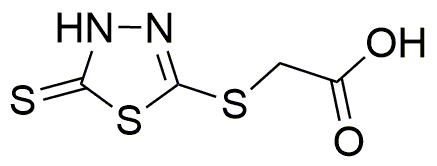(5-Mercapto-1,3,4-thiadiazol-2-ylthio)acetic acid is widely utilized in research focused on:
- Pharmaceutical Development: This compound is explored for its potential in developing new medications, particularly in targeting specific diseases due to its unique thiadiazole structure, which can enhance drug efficacy.
- Agricultural Chemistry: It is used in formulating agrochemicals, such as fungicides and herbicides, providing effective solutions for crop protection while minimizing environmental impact.
- Analytical Chemistry: The compound serves as a reagent in various analytical methods, helping researchers detect and quantify metal ions in environmental samples, which is crucial for pollution monitoring.
- Material Science: It is incorporated into the development of novel materials with specific properties, such as improved conductivity or stability, making it valuable in electronics and nanotechnology.
- Biochemical Research: The compound is studied for its role in biochemical pathways, offering insights into cellular processes and potential therapeutic targets, which is essential for advancing medical research.
General Information
Properties
Safety and Regulations
Applications
(5-Mercapto-1,3,4-thiadiazol-2-ylthio)acetic acid is widely utilized in research focused on:
- Pharmaceutical Development: This compound is explored for its potential in developing new medications, particularly in targeting specific diseases due to its unique thiadiazole structure, which can enhance drug efficacy.
- Agricultural Chemistry: It is used in formulating agrochemicals, such as fungicides and herbicides, providing effective solutions for crop protection while minimizing environmental impact.
- Analytical Chemistry: The compound serves as a reagent in various analytical methods, helping researchers detect and quantify metal ions in environmental samples, which is crucial for pollution monitoring.
- Material Science: It is incorporated into the development of novel materials with specific properties, such as improved conductivity or stability, making it valuable in electronics and nanotechnology.
- Biochemical Research: The compound is studied for its role in biochemical pathways, offering insights into cellular processes and potential therapeutic targets, which is essential for advancing medical research.
Documents
Safety Data Sheets (SDS)
The SDS provides comprehensive safety information on handling, storage, and disposal of the product.
Product Specification (PS)
The PS provides a comprehensive breakdown of the product’s properties, including chemical composition, physical state, purity, and storage requirements. It also details acceptable quality ranges and the product's intended applications.
Certificates of Analysis (COA)
Search for Certificates of Analysis (COA) by entering the products Lot Number. Lot and Batch Numbers can be found on a product’s label following the words ‘Lot’ or ‘Batch’.
Numéro de catalogue
Numéro de lot/série
Certificates Of Origin (COO)
This COO confirms the country where the product was manufactured, and also details the materials and components used in it and whether it is derived from natural, synthetic, or other specific sources. This certificate may be required for customs, trade, and regulatory compliance.
Numéro de catalogue
Numéro de lot/série
Safety Data Sheets (SDS)
The SDS provides comprehensive safety information on handling, storage, and disposal of the product.
DownloadProduct Specification (PS)
The PS provides a comprehensive breakdown of the product’s properties, including chemical composition, physical state, purity, and storage requirements. It also details acceptable quality ranges and the product's intended applications.
DownloadCertificates of Analysis (COA)
Search for Certificates of Analysis (COA) by entering the products Lot Number. Lot and Batch Numbers can be found on a product’s label following the words ‘Lot’ or ‘Batch’.
Numéro de catalogue
Numéro de lot/série
Certificates Of Origin (COO)
This COO confirms the country where the product was manufactured, and also details the materials and components used in it and whether it is derived from natural, synthetic, or other specific sources. This certificate may be required for customs, trade, and regulatory compliance.

